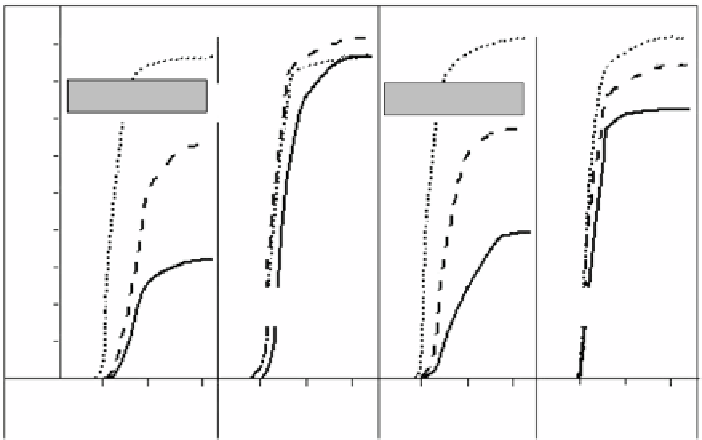Agriculture Reference
In-Depth Information
loamy sand
clay loam
90
top
chopped straw
chopped straw
70
50
30
ground straw
ground straw
10
5 0 5
5
10
15
5 0 5
5
10
15
days from sowing
days from sowing
days from sowing
days from sowing
Fig. 8.14
Emergence of rape (colza) depending on the size reduction and the location of barley
straw within soils from experiments in a laboratory (From Heege and Vosshenrich
2000
)
The effect of both factors depends on sizes of loose residues
.
It is well known that substantially reducing the sizes of loose crop residues can
do away with clogging problems of sowing machines and hence provide for a pre-
cise sowing depth. Yet how is the water transfer from the soil to the seeds - and thus
the germination and emergence - affected by a reduction of residue sizes and the
location of residues within the soil? Figure
8.14
shows results to these questions for
the interactions between rape (colza) seed and barley straw from laboratory experi-
ments with two soils. The straw was either chopped, ground or left out completely.
The order of increasing emergence - with one exception - was straw mixed into the
soil, straw on the top of the soil, no straw applied. The exception occurred with the
loamy sandy soil and ground straw; for this combination the alternatives in straw place-
ment hardly did matter. In all cases, grinding the straw instead of chopping it clearly
improved the emergence. Similar results as with rape were obtained for small grains
with the exception that the differences between the treatments were somewhat smaller.
In short, a distinct reduction of straw sizes during harvesting can help to solve
residue problems. Utilizing this effect would necessitate to have grinders instead of
choppers on combines and to increase their engine-power for doing this. An appeal-
ing prospect of this option would be that it allows to realize a good seed distribution
over the area via small row widths with no-till of small grains and rape (colza) and
thus to have the yield advantages associated with this (Fig.
8.5
).
However, it should be pointed out that significantly smaller straw sizes would
decrease the erosion control by residues. This effect would probably weigh heavily
in regions with continental climate and susceptible soils, whereas in areas with mar-
itime climate it probably can be neglected.




